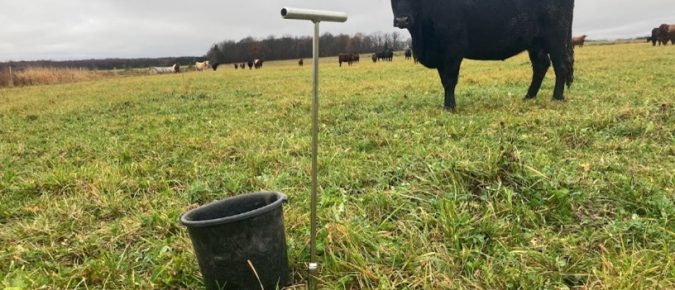Each year, in May when the dandelions start showing their faces, the most common topic of discussion in the grazing and livestock world is “When can I start grazing?” While those lush, green pastures look awfully inviting after months of feeding hay, farmers must pause and make a wise, informed decision regarding when to start grazing because starting too soon can result in a dramatic shortening of a month or more at the end of the grazing season.
The fourth Focus on Forage webinar in the 2024 series, Focus on Pastures, features research-based pasture establishment and management recommendations and resources to keep pastures productive throughout the 2024 growing season.
Also commonly referred to as “stocking rate,” carrying capacity is the number of animals a parcel of land can support by providing adequate feed and retaining and recycling the nutrients they produce. In grazing systems, where livestock harvest their own feed and spread their own manure, carrying capacity is foundational to a long grazing season that results in healthy animals, healthy pastures, and a healthy ecosystem.
The beginning of a new year is always a good time to consider ways to improve a farm for greater long-term success. A way to improve long-term success is to consider how to make a farm more resilient. In the constant pursuit of increased production, resilience is often overlooked, undervalued, and perhaps misunderstood. But what exactly is resilience?
Managing forage inventory is a pivotal task on any grazing operation. A forage inventory involves monitoring how much forage is available at various points of the season, as well as projecting forage availability throughout the season to ensure the farm is on track to meet its production goals.
When the calendar turns to August, it’s usually time to think about setting pastures up for stockpile grazing. Stockpile grazing is the practice of letting pastures grow through fall (usually 60 days or more) until frost, and then grazing them as far into winter as conditions allow. Stockpile grazing is often set into motion in early August harvest.
Variable corn stands, short hayfields, and parched pastures are par for the course with the drought this growing season. As a result, graziers are already dipping into stored winter feed, while hay supplies become increasingly limited and expensive.
Cool-season grasses are highly dependent on regular rainfall, with 1 to 1.5 inches a week needed for sustained optimal growth through the summer. While dry and hot conditions in July and August frequently result in a “summer slump”, longer periods of deficient rainfall can dramatically reduce pasture production. Poor management during drought can slow pasture recovery after the rain starts falling again.
A high-quality forage base is the foundation of every successful grazing operation. Good grazing management and attention to soil fertility are central to keeping pastures healthy and productive, but there are times when renovation is the best option for improving productivity or fixing problems in a pasture.
Many beef and small ruminant producers are looking forward to pastures greening up in Wisconsin. In some pastures that will include troublesome weeds. Management timing for weed control is narrow for some species and can be the difference between success and a waste of time and money.
Soil seems to be the hot-button topic of nearly every farmer-focused event and agricultural publication these days. While it’s ironic that this resource, which predates modern agriculture itself, has become the rising star of modern agriculture, it’s appropriate because soil is the foundation of everything we do. Few would argue that the health and long-term productivity of our soil is the most critical factor for the future of agriculture and society.
Stockpile grazing is a technique that can help minimize the high cost of winter feeding. A goal common to nearly all grazing operations is extending the grazing season as late into the year as possible. Using livestock to harvest forage is the most cost-effective method of feeding your animals, and every additional day of grazing has positive implications on farm finances.
















